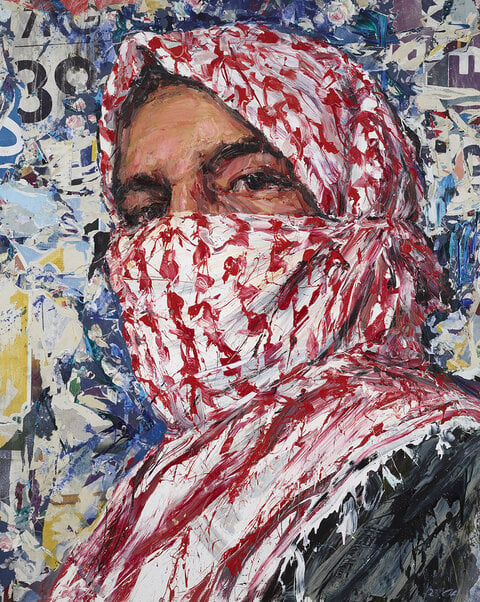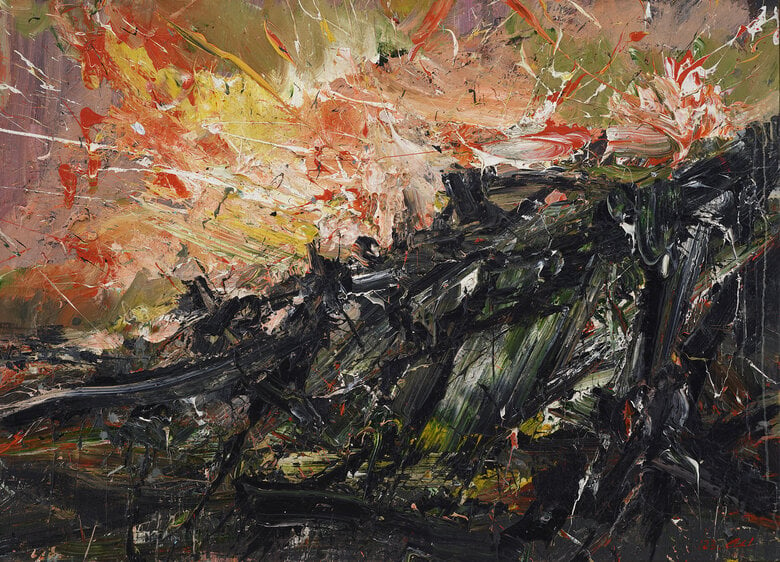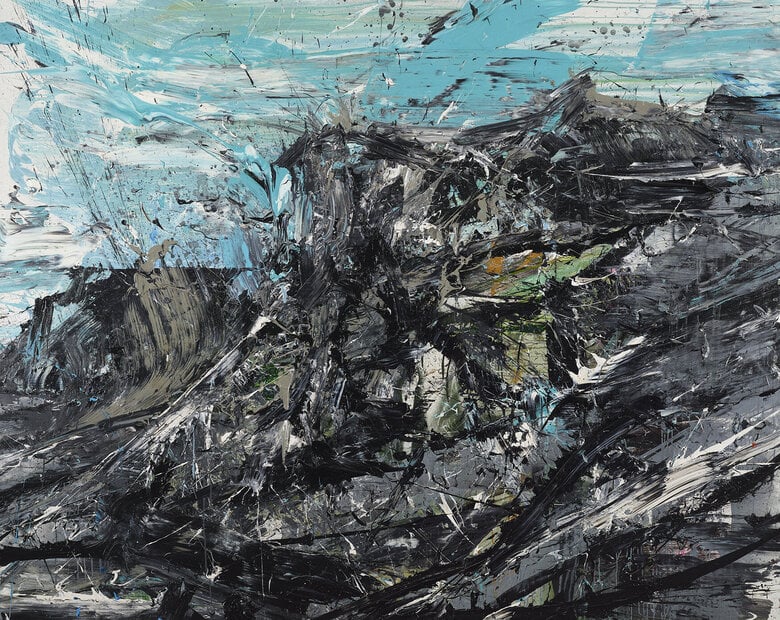Ayman Baalbaki, a contemporary visual artist, was born in 1975 in Ras-el-Dekweneh in Beirut, Lebanon. Originally from Adaisseh, a village in south Lebanon, his parents relocated to Wadi Abu Jamil...


AYMAN BAALBAKI, Lebanon (1975)
Bio
Written by WAFA ROZ
Ayman Baalbaki, a contemporary visual artist, was born in 1975 in Ras-el-Dekweneh in Beirut, Lebanon. Originally from Adaisseh, a village in south Lebanon, his parents relocated to Wadi Abu Jamil neighborhood in central Beirut, where Ayman was raised. His father, Fawzi Baalbaki, and his uncle Abdelhamid Baalbaki (1940-2013) were both visual artists and educators. Also, Said, Ayman's brother, and two of his cousins, Oussama and Hoda, are now established visual artists. Ayman finished his secondary education at the Ahlieh School in Wadi Abu Jamil in 1994[1] and then earned his diploma in fine arts from the Lebanese public University in Beirut in 1998. He did a one-year mandatory military service before moving to Paris in 2000. Ayman studied Art et Espace at the École Nationale des Arts Décoratifs (ENSAD) in Paris from 2000 to 2002 and completed his D.E.A in the art of images and contemporary art at Université Paris VIII from 2002-2003. In the summers of 2001 and 2002, Ayman attended the Ayloul Summer Academy in Amman, Jordan, a program led by renowned Syrian-German modernist Marwan Kassab Bachi (1934-2016), who later mentored Ayman.[2]
Baalbaki grew up during the Lebanese Civil War (1975-1990). As a young boy, he witnessed shelling, snipers, destruction, and the Israeli invasion of Beirut. Wadi Abu Jamil, previously known as the Jewish quarter, became a refugee haven for Kurds and Lebanese southerners fleeing the Israeli assaults. Baalbaki and his family stayed there for nearly two decades. In 1995, they moved to Haret Hreik in the southern suburbs of Beirut.[3] Sadly, Haret Hreik was razed to the ground during the 2006 Israel-Hezbollah July war, and the Baalbaki’s were displaced once again.
The memory of the Lebanese Civil War is a sensitive subject for many Lebanese. The war ended with the 1989 Ta’if Accord and the 1991 amnesty law that pardoned all political crimes before that date.[4] But, Baalbaki chooses to face the past or attend to a “devoir de mémoire,’’ as he puts it. A critical and imaginative artist, Baalbaki tackled the war’s painful events with cynicism, only to underscore the absurdity of war. Baalbaki’s body of work, including painting, installation, and sculpture, revolves around themes such as collective memory, loss, displacement, and identity. Rapidly, Baalbaki earned international acclaim for his staggering hyper-expressive paintings.
Baalbaki’s most alarming paintings are ones that depict havoc in the aftermath of war. These paintings belong to two ongoing series; one is Tammouz, which he started in 2007, as an elegy to the ravaged southern suburbs of Beirut, following the 2006 July war, and another, Contre-Jour, which he began in 2009.[5] Contre Jour is a play on words. It translates to Against Daylight in English, alluding to barbaric acts executed in broad daylight. Both series picture the destruction of individual architectural buildings in Beirut. In some of his paintings, Baalbaki depicts giant concrete bullet-riddled buildings in progressive collapse. Marked with despair and abandonment, most canvases amass crumbling ruins and debris. Baalbaki’s acrylics on canvas buildings usually occupy the center of his canvas; black and grim like emblems of disaster. Baalbaki lightens the mood of his paintings with gaudy backgrounds toned in altered palettes of yellow, blue, green, or pink. At times, he mounts ready-made floral fabrics to the stretched canvas before he begins a piece.
Onto these flowery backdrops, Baalbaki applies paint in flat thick gestural brushstrokes, in an effort to re-enact modern warfare. Most paintings are untitled. Still, one is entitled Immeuble Yassine, 2010.[6] It features a ravaged building in Haret Hreik, where the Baalbakis once lived.
Baalbaki speaks of how he was inspired by the floral fabrics adopted in the ‘Kitschy ’outfits of the Lebanese southerners and Kurds who inhabited Wadi Abu Jamil. Baalbaki envisages these people “kept their once left gardens and orchards in the floral fabric of their outfits.” The floral fabrics also reminded him of the clothes that people hung on their balconies on laundry lines, and which they had to leave behind during the 2006 July war.[7]
As a commemoration, Baalbaki paints Beirut’s civil war landmarks – famous hotels and high-rise buildings that are now peppered with shrapnel and bullets. Baalbaki painted the Burj al Murr tower, the Holiday Inn hotel, the ‘’Barakat sniper building’’ (recently turned into the Beit Beirut Museum), and "the Egg,” a nicknamed old movie theater. In these paintings, his work takes on a personal and political dimension. These buildings are located along the infamous “green line,” which once separated the militant factions of west Beirut from their rivals in east Beirut. The line was a footstep away from Wadi Abu Jamil.
Baalbaki often incorporates text into his work, either in the form of metal stencil or neon light. For example, at the bottom of The Sniper,2009,[8] acrylic on fabric mounted on canvas painting, Baalbaki places a horizontal stenciled copper sheet that reads al-qannas in Arabic, meaning sniper. Al-qannas is backlit in striking yellow, while the painting features the tall hulky building of the Holiday Inn hotel, which was a sniper’s nest during the war. The pop sign gives the painting a look of some Egyptian movie poster. Baalbaki’s Holiday Inn testifies to the transformation of a touristic haven, a place where movies were shot, to a fortress of war. Likewise, in 2009, during a solo show in London, Baalbaki displayed a blue neon light installation onto the glass façade of the gallery’s entrance. It read “Ceci n’est pas la Suisse,” also the title of the show. His ‘pop art’ intervention resonates with Rene Magritte's surreal image-word painting “Ceci n'est pas une pipe;” it mocks the fact that Lebanon was famously called “the Switzerland of the Middle East” before the war. Baalbaki said, “I wanted to incorporate in my work a textual aspect which is omnipresent in Arab culture.”[9]
Baalbaki’s understanding of the significance of text in Arab culture goes back to his formative education years. His father was keen on teaching his children traditional Arabic poetry, specifically the pre-Islamic odes, al-Mu’allaqat. Besides learning the verses, Baalbaki gained insight from the thematic structure of the poems. Author Michel Fani was the first to relate Baalbaki’s art, contextually, to the thematic structure of al-Mu’allaqat. Fani explains, “three themes are at the heart of pre-Islamic poetry: a special relationship to space and place, wandering, and identity.” And then asks, “are they not exactly what guides Ayman Baalbaki’s brush and inspiration?”[10]
Indeed Baalbaki depicts displacement and wandering in a sequence of installations entitled Destination X, which he started as early as 2004. Drawing from Arte Povera, he deploys pre-used or cheap everyday objects. Destination X, 2010, for example, which was shown in Liverpool in 2010, comprises of a worn-out red Fiat placed on a rotating platform with a neon light rim around it.[11] The car is loaded with household furniture and beddings all tied up in a bundle on the roof of the vehicle: floral mattresses, pillows, bags, chairs, and plastic buckets. The bright colors and clumsy setup suggest frivolousness, even when the theme is not humorous at all. This play, in contrast between material and context, is also realized in Baalbaki's 2013 Murano glass sculptures depicting car tires and X shaped metal barriers as border checkpoints.
In one of his most celebrated and controversial sequence of portraiture known as al-Mulatham (the masked), Baalbaki experiments with the often-contradictory themes of anonymity and visibility. Large-scale paintings, in acrylic on fabric laid on canvas, feature one gigantic bust view portrait of a fida’i (a freedom fighter) against a vibrant flowery background.[12] The head and face are obscured in a white and red checkered keffiyeh, and only the shadowed sharp eyes are spared. Though stunning in their animated patterns and bright colors, the portraits echo uncertainty and disillusionment. Baalbaki explains that these portraits “incarnate both hope and despair.” He also adds, “in every portrait, I seek to offer a different interpretation and a new way of reading.” [13]Curiously, author Michel Fani perceives al- Mulatham as Baalbaki’s self-portrait in the guise of a fida’i. The word fida’i is usually associated with Palestinian freedom fighters. However, it generally translates to “the one who sacrifices himself” and is associated with Christ as savior. Therefore, the fida’i can be anyone seeking redemption or salvation.
In al-Mulatham, Baalbaki examines the keffiyeh as an iconographic symbol. The keffiyeh, a white square cotton scarf checkered in black or red, was initially used as a traditional headdress and soon evolved into a glorified symbol of the Palestinian resistance. In the west, it has become a symbol of Islamist extremists. However, for Baalbaki, Al-Mulatham is neither a glorified symbol nor a symbol of terror. Though Baalbaki’s keffiyeh is imposing, it is painted with frenzied red and white brush strokes. The fida’i holds no weapons and is drawn against a ‘kitschy’ background. Al-Mulatham is a complex and often misread masked hero.
What is most remarkable about Baalbaki is his signature expressionist style. This is best exemplified in one of his seminal mixed media on canvas paintings entitled The Middle East, 2014 measuring 207.5x407.5 cm.[14] Approaching the large-scale artwork, one is faced with an explosion of paint in all directions - paint splashed, smeared, and dripping. The painting features the carcass of a wrecked Middle East Airlines airplane with the green cedar tree logo marked on its remaining red tail. At a closer look, the viewer discovers that cut out prints and floral fabric lie underneath a thick stratum of burgundy, grey, red and turquoise color palette. This painting registers the bombing of the Beirut airport by Israeli forces in 1982. One more artwork dedicated to Lebanon’s eclipsed turbulent history.
“Most of the time, I don't do preparatory studies," says Baalbaki. “I start to paint spontaneously, and the painting takes over. It’s very violent,”[15] he adds. The artist draws inspiration from German Expressionism, Neo-Expressionism, and Abstract Expressionism or Tachisme. Baalbaki surely applies paint in aggressive brushstrokes. At other times, he uses spray paint, or strikes masses of acrylic paint from a distance onto his canvas. He completes the desired picture in nearly one sitting. However, he revisits a painting several times before considering it done. This process sometimes takes him years.[16]
A free soul and an inspiring artist, Baalbaki currently lives and works in Beirut, Lebanon.
Notes
[1] Roz Wafa. Ayman Baalbaki Interview. Personal, May 16&19, 2020.
[2] Issa, Rose. “Biography .” Essay. In Ayman Baalbaki, Beirut Again and Again, 100. London: Beyond Art Production, 2011.
[3] Roz Wafa. Ayman Baalbaki Interview. Personal, May 16&19, 2020.
[4]“The Ta’if Accord that ended the war in 1989 failed to resolve or even address the core conflicts of the war, including the sectarian division of power in Lebanon,” “The Historiography and the Memory of the Lebanese Civil War.” Portail Sciences Po, October 25, 2011. https://www.sciencespo.fr/mass-violence-war-massacre-resistance/fr/document/historiography-and-memory-lebanese-civil-war.html.
[5] Roz Wafa. Ayman Baalbaki Interview. Personal, May 16&19, 2020.
[6] Tammouz Destruction & Loss,". In Ayman Baalbaki, Beirut Again and Again, 47. London: Beyond Art Production, 2011.
[7] Roz Wafa. Ayman Baalbaki Interview. Personal, May 16&19, 2020.
[8] Issa, Rose. “Ayman Baalbaki in Conversation with Rose Issa.” Essay. In Ayman Baalbaki, Beirut Again and Again, 18. London: Beyond Art Production, 2011.
[9] “Breakfast at Baalbaki's - Artbahrain.” Accessed May 21, 2020. http://artbahrain.org/wp2017/breakfast-at-baalbakis/.
[10] Fani, Michel. “Ayman Baalbaki: Searching for Lebanon's Soul.” Essay. In Ayman Baalbaki, Beirut Again, and Again, 25. London: Beyond Art Production, 2011.
[11] “ ‘Errance’ Displacement & Wandering .” Essay. In Ayman Baalbaki, Beirut Again, and Again, 76. London: Beyond Art Production, 2011.
[12] The Middle East,2014, mixed media painting is part of DAF collection.
[13] “Breakfast at Baalbaki's - Artbahrain.” Accessed May 21, 2020. http://artbahrain.org/wp2017/breakfast-at-baalbakis/.
[14] One of the Al-Mulatham, acrylic on fabric laid on canvas, paintings dated 2013, (250x200cm) is part of DAF collection.
[15] Stoughton, India. “Ayman Baalbaki.” Executive Life, October 13, 2016. http://life.executive-magazine.com/art-culture/artists/ayman-baalbaki.
[16] Roz Wafa. Ayman Baalbaki Interview. Personal, May 16 &19, 2020.
Sources
“Ayman Baalbaki: Switzerland It Ain't (Ceci N'est Pas La Suisse).” Ayman Baalbaki: Switzerland it ain't (Ceci n'est pas la Suisse) | OneArt.org. Accessed May 21, 2020. http://www.oneart.org/galleries/ayman-baalbaki-switzerland-it-aint-ceci-nest-pas-la-suisse.
Amaya-Akkermans, Arie. “The Here of the Elsewhere.” The Mantle. Accessed May 21, 2020. http://www.mantlethought.org/a...
Associated Press. “Scars of Lebanon's Civil War in Beirut 30 Years after Guns Fell Silent - in Pictures.” The National. The National, April 13, 2019. https://www.thenational.ae/wor...
ABC News. ABC News Network. Accessed May 21, 2020. https://abcnews.go.com/blogs/h...
Agial Art Gallery & Saleh Barakat Gallery - Baalbaki, Ayman. Accessed May 21, 2020. http://www.agialart.com/Artists/Details_e/6/Baalbaki-Ayman.
“Breakfast at Baalbaki's - Artbahrain.” Accessed May 21, 2020. http://artbahrain.org/wp2017/breakfast-at-baalbakis/.
Dagen, Philippe. “The Arab Spring Hits Paris.” The Guardian. Guardian News and Media, November 1, 2011. https://www.theguardian.com/artanddesign/2011/nov/01/arab-spring-art-exhibition-paris.
Issa, Rose, Ayman Baalbaki, Beirut Again and Again, London: Beyond Art Production, 2011.
“Laughter into Tears: Ayman Baalbaki's Destination X.” Satellite Gallery Blog, August 17, 2013. https://satellitegallery.wordpress.com/2013/08/17/laughter-into-tears-ayman-baalbakis-destination-x/.
Proctor, Rebecca Anne. “'You Make a Decision to Continue': Amid a Crushing National Deficit, Beirut's Art Scene Finds Creative Ways to Stay Afloat.” artnet News, October 1, 2019. https://news.artnet.com/market/beirut-2-1662709.
Stoughton, India. “Ayman Baalbaki.” Executive Life, October 13, 2016. http://life.executive-magazine.com/art-culture/artists/ayman-baalbaki.
The Historiography and the Memory of the Lebanese Civil War.” Portail Sciences Po, October 25, 2011. https://www.sciencespo.fr/mass-violence-war-massacre-resistance/fr/document/historiography-and-memory-lebanese-civil-war.html.
“The Inherited Wars.” Guggenheim, June 16, 2016. https://www.guggenheim.org/blogs/map/the-inherited wars. wars.
Saleh Barakat . “Ayman Baalbaki /Blobak/.” Ayman Baalbaki /Blobak/. Beirut, Lebanon: Saleh Barakat Gallery,2016.
Wilson-Goldie, Kaelen. “The Art of War.” The National. The National, November 3, 2008. https://www.thenational.ae/arts-culture/art/the-art-of-war-1.513835.
CV
Selected Solo Exhibitions
2025
Pourquoi il fait si sombre?, Dalloul Art Foundation, Beirut, Lebanon
2022
Ayman Baalbaki: Beirut Kaputt?, Mina Image Centre, Beirut, Lebanon
2016
Blowback, Saleh Barakat Gallery, Beirut, Lebanon
2014
Recent Works, Rose Issa Projects Space, London, UK
2013
Hanoi / Hong Kong, Luce Gallery, Torino, Italy
2011
Beirut again and again, Rose Issa Projects, London,UK
2010
Ciel chargé de fleurs, Luce Gallery, Turin, Italy. (solo)
2009
Ceci n’est pas la Suisse, Rose Issa Projects, London, UK
2008
Apocalyptic Transfiguration, Agial Art Gallery, Lebanon.
2007
T-Marbouta, Beirut, Lebanon
2006
Ici est ailleurs,Agial Art Gallery, Beirut, Lebanon
2002
Présence Absence, Maison du Liban, France
Selected Group Exhibitions
2024
Hope in an age of Dystopia, Ramzi and Saeda Dalloul Art Foundation (DAF), Beirut, Lebanon
The Little Prince of Gaza, Ramzi and Dalloul Art Foundation (DAF), Beirut, Lebanon
Carpets of Eden, Gardens of Fantasy, Leila Hiller Art Gallery, Dubai, United Arab Emirates
2023
Lebanon|Untitled: Modern & Contemporary Lebanese Art, Janet Rady Art Gallery, London, United Kingdom
2022
20 Ans Avec Les Artistes, Art Absolument Art Space, Paris, France
How will it end?, Fondation Boghossian, Brussels, Belgium
The 59th Venice Art Biennale - La Biennale di Venezia, Venice, Italy
2019
BEYOND: Modern & Contemporary Lebansese Art and Design, Phillips, London, United Kingdom
45th Bahrain Annual Fine Arts Exhibition, Bahrain
A la plume, au pinceau, au crayon: dessins du monde arabe, Institut du Monde Arabe, Paris, France
2018
Le Monde arabe vu par ses artistes, Institut du Monde Arabe, Paris, France
Scripted reality,Lawrie Shabibi, London, UK
Group exhibition, Beit Beirut, Beirut, Lebanon
Hommage à Marwan, Galerie Pankow, Berlin, Germany
Drucksache, Galerie Pankow, Berlin, Germany
Face Value: Portraiture (A Gallerist’s Personal Collection), Saleh Barakat Gallery, Beirut, Lebanon
2017
Ourouba: The Eye of Lebanon, BAF, curated by Rose Issa, Beirut, Lebanon
2014
Thin Skin: six artists from Beirut, Taymour Grahne Gallery, New York
2013
Glasstress: White Light / White Heat, 55th Venice biennale, Palazzo Franchetti, Italy
Safar/Voyage: Contemporary works by Arab, Iranian and Turkish artists, MOA, Museum of Anthropology, Vancouver, Canada
25 ans de créativité Arabe, Institut du Monde Arabe, Paris, France
25 years of Arab Creativity, Abu Dhabi Festival, UAE
2012
Art is the answer!,Villa Empain (Boghossian Foundation), Brussels, Belgium
Traits d’Union – Paris et l’art contemporain arabe, The Venue, Beirut, Lebanon
Traits d’Union – Paris et l’art contemporain arabe, Musée National de Sanaa, Yemen
Re-Orientation II, Rose Issa Projects, London, UK
2011
“The Future of a Promise”,54thVenice biennale, Italy
Contemporary Lebanese Art Exhibition, Royal College Of Art, London, UK
Traits d’Union – Paris et l’art contemporain arabe, Villa Emerige, Paris, France
The Future of a Promise, 54th Venice biennale, Italy
Modern and Contemporary Arab, Iranian and Turkish Art, Christie’s, Dubai, UAE
2010
Beirut City Center, Beirut, Lebanon
Nujoom: Constellations of Arab Art from The Farjam Collection, Dubai, UAE
Convergence: New Art From Lebanon, Washington, USA
Connecting Heavens, Green Art Gallery, Dubai, UAE
Arabicity: Such A Near East, Liverpool, UK
Arabicity, Beirut exhibition center, Beirut, Lebanon
Kasa 10.yil, Sabanci University’s “Kasa Art Gallery”, Istanbul, Turkey
2009
In the Middle of the Middle,Sfeir-Semler, Beirut, Lebanon
Rafia Gallery, Damascus, Syria
2008
Bos laf, Sabanci University’s “Kasa Art Gallery”, Istanbul, Turkey
2007
Shatana workshop, Shatana, Jordan
2006
Homage to Léopold-Sédar Senghor, Beirut, Lebanon
Arteclassica, 3era. Feria de Arte, Buenos Ayres, Argentina
2005
National Museum of Niger, Niamey, Niger
XXIII biennial of Alexandria of the countries of the Mediterranean, Egypt
Studio 4-11, Belfast, UK
2004
EL BAB, Shams – Theatre of Beirut, Lebanon
2003
Cm³,CIUP, France
Cerfs-volants d’artistes, Maison du Liban, CIUP, France
2002
Imagining the Book, Bibliotheca Alexandrina, Egypt
Manufacture des Oeillets(ENSAD), Paris, France
Mulhouse 002, Acadamy of art in France, Mulhouse, France
2001
Zara Gallery, Amman, Jordan
Darat Al Funun, Amman, Jordan
2000
CIUP, France
Association of the Lebanese Artists, Beirut, Lebanon
1998
Cultural center of Southern Lebanon, Beirut, Lebanon
JABAL 98, Tripoli, Lebanon
1997
Lebanese cultural Movement, Tyr, Lebanon
1996
Empreintes, Maraya Gallery, Beirut, Lebanon.
Awards and Honors
2005
Jeux de la francophonie 2005, Silver Medal (painting), Niamey, Niger
2003
Cm³(first prize), CIUP, France
1996
“EMPREINTES”(first prize), organized by Maraya Gallery and Lebanese
Ministry of Culture and Higher Education, Beirut, Lebanon
Publications
2011
Beirut and Again and Again, edited by Rose Issa, Beyond Art Productions
2009
Can one many save the (art world), Georges Rabbath and Nayla Tamraz, Alarm Editions
2008
Ayman Baalbaki, Transfiguration Apocalyptique, Agial Art Gallery
Collections
Ramzi and Saeda Dalloul Art Foundation, Beirut, Lebanon
KA Collection, Beirut, Lebanon
British Museum, UK
The Mokbel Art Collection, Beirut, Lebanon
Institut du Monde Arabe, Paris, France
Tate Modern, London, UK
Documents
Ayman Baalbaki Transfiguration Apocalyptique
Joseph Tarrab- Alain Tasso
Agial Art gallery, English, 2008
Exhibition Catalogue
Press
The IMA pays tribute to France and Claude Lemand, generous patrons and passionate companions of artists
Clotilde Scordia
www.happening.media, English, 2024
Carpets of Eden, Gardens of Fantasy
www.mutualart.com, English, 2024
Exhibition at Leila Heller Gallery, Dubai, United Arab Emirates
CARPETS OF EDEN GARDENS OF FANTASY
www.mutualart.com, English, 2024
Exhibition at Leila Heller Gallery, Dubai, United Arab Emirates
Christie’s Pulls Paintings by Lebanese Artist After “Complaints”
Rhea Nayyar
www.hyperallergic.com, English, 2023
Ayman Baalbaki paintings withdrawn from Christie's auction after complaints
Razmig Bedirian
www.thenationalnews.com, English, 2023
Two paintings, which depict revolutionary figures, removed daysrnbefore London sale
"The World in the Image of Man" at Venice Biennale
Nafiseh Saleh Abadi
www.biennale.org, English, 2022
Lebanon pavilion at Venice Biennale 2022
BEING AYMAN BAALBAKI
Wafa Roz
www.selectionarts.com, English, 2022
How will it end? - Boghossian Foundation
www.villaempain.com, English, 2022
The exhibition, designed in co-production with the Pompidou Centre, offers an unprecedented dialogue between its exceptional collections and pieces by Lebanese artists of all generations
‘We are in a period of explosion of photos, the camera and the photos are everywhere, surely they became essential and heavy.’ – Ayman Baalbaki
Lizzy Vartanian Collier
www.tribephotomagazine.com, English, 2022
Serwan Baran in being Ayman Baalbaki
Serwan Baran
www.selectionarts.com, English, 2022
العالم منزلي: لقاء مع أيمن بعلبكي
ستيفن تايت ترجمة: يامن صابور
Awan Media, Arabic, 2019
BEIRUT KAPUTT?
Anastasia Nysten
www.selectionarts.com, English, 2021
« Beirut Kaputt ? » ou les multiples visages de l’horreur
Gilles Khoury
www.lorientlejour.com, French, 2021
BEYOND: Modern and Contemporary Lebanese Art and Design
www.philips.com, English, 2019
Phillips and the Lebanese International Finance Executives Auction Charity
موضوع الأطلال في أعمال أيمن بعلبكي
نايلة تمرز ترجمة: يامن صابور
Awan Media, Arabic, 2019
أيمن بعلبكي: التلذّذُ بالسلبيّ والنماءُ فيه
بول أردان ترجمة: ثائر ديب
Awan Media, Arabic, 2019
Object lessons: from a political work by Ayman Baalbaki to photo albums of Bonnie and Clyde
Gabriella Angeleti, Margaret Carrigan and Kabir Jhala
The Art Newspaper, English, 2019
Breakfast at Baalbaki’s
Valerie Didier-Hess
Art Bahrain, English, 2017
From war zone to haven: the view from Beirut
Maya Jaggi
Financial Times, English, 2017
Six Contemporary Artists from Lebanon at Taymour Grahne Gallery
Lisa Pollman
Culture Trip, English, 2017
La culture est un objet de consommation
josée hansen
d’Lëtzebuerger Land, French, 2016
فن أيمن بعلبكي اكتشاف للذّات من خلال تجربة الحرب
سلاف زكريا
Bidayat Mag, Arabic, 2016
أيمن بعلبكي يجعل من الركام جمالاً
مهى سلطان
al hayat, Arabic, 2016
أیمن بعلبكي...« الإنفجار» الكبیر
نیكول یونس
Al Akhbar, Arabic, 2016
أيمن بعلبكي يرسم العدمية خارج الزمان والمكان
ميموزا العراوي
Al Arab, Arabic, 2016
Ayman Baalbaki
INDIA STOUGHTON
Life Executive magazine, English, 2015
Thin Skin: Six Artists from Beirut
Wall Street International Magazine, English, 2014
Thin Skin: Six Artists from Beirut
Holland Cotter
New York Times, English, 2014
THE HERE OF THE ELSEWHERE
Arie Amaya-Akkermans
The Mantle, English, 2014
بلاد الأرز... عندما يكون الفن والجمال أداة للانتقام
كيرستن كنيب ترجمة: نادر الصراص
dw.com, Arabic, 2012
Laughter into Tears: Ayman Baalbaki’s Destination X
Rhys Edwards
www.satellitegallery.wordpress.com, English, 2013
Exposition Collective, Traits d'union, Paris et l'art contemporain arabe, Multimédia, Villa Emerige, Paris, France
Art Limited, French, 2011
The Arab spring hits Paris
Philippe Dagen
The Guardian, English, 2011
Contemporary art: Spotlight falls on the collectible generation
Abigail Fielding-Smith
Financial Times, English, 2011
Exposition « Traits dʼunion, Paris et lʼart contemporain arabe »
Thierry Savatier
Savatier Blog, French, 2011
BLOWBACK’ AT SALEH BARAKAT ART GALLERY
Agenda Culturel, English
Arabicity signals a bright future for Beirut's art
Kaelen Wilson-Goldie
The National, English, 2010
The art of war
Kaelen Wilson-Goldie
The National, English, 2008
Ayman Baalbaki's latest exhibition turns an elegiac lens on the devastation of his hometown of Beirut.
Taking a sense of place - and moving it
Kaelen Wilson-Goldie
The Daily Star, English, 2006
AYMAN BAALBAKI Artwork
Related with AYMAN BAALBAKI
Become a Member
Join us in our endless discovery of modern and contemporary Arab art
Become a Member
Get updates from DAF
Follow Artists
Save your favourite Artworks
Share your perspectives on Artworks
Be part of our community
It's Free!
We value your privacy
TermsCookiesPrivacy Policies
Become a Member
Get updates from DAF
Follow Artists
Save your favourite Artworks
Share your perspectives on Artworks
Be part of our community
It's Free!
We value your privacy
TermsCookiesPrivacy Policies
Become a Member
Get updates from DAF
Follow Artists
Save your favourite Artworks
Share your perspectives on Artworks
Be part of our community
It's Free!
We value your privacy
TermsCookiesPrivacy Policies
Welcome to the Dalloul Art Foundation
Thank you for joining our community
If you have entered your email to become a member of the Dalloul Art Foundation, please click the button below to confirm your email and agree to our Terms, Cookie & Privacy policies.
We value your privacy, see how
Become a Member
Get updates from DAF
Follow Artists
Save your favourite Artworks
Share your perspectives on Artworks
Be part of our community
It's Free!
We value your privacy
TermsCookiesPrivacy Policies

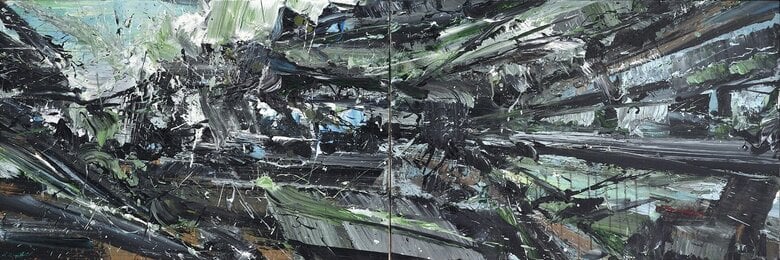



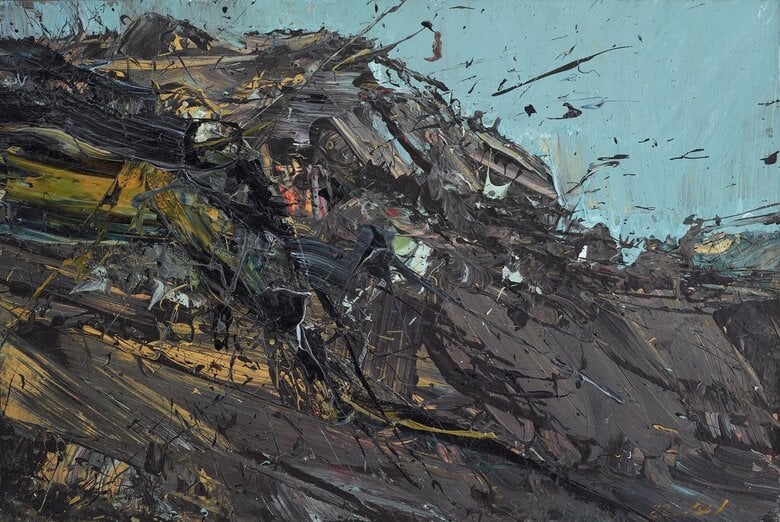

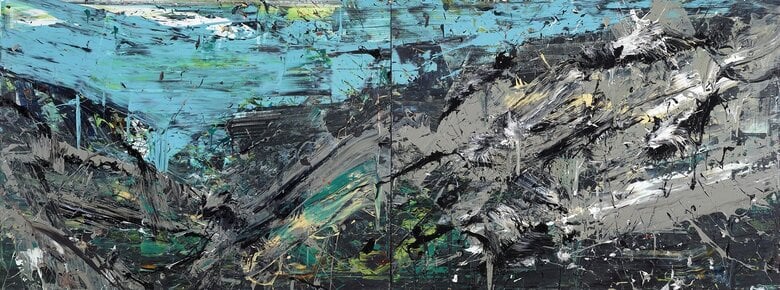

.jpg)
.jpg)

